The picture is known to every person; it is passed through almost elementary school, and it’s unlikely to forget such a masterpiece afterwards. In addition, this well-known and beloved reproduction constantly adorns the packaging of chocolate of the same name and is an excellent illustration for stories.
The plot of the picture
This is probably the most popular painting I.I. Shishkin, the most famous landscape painter, whose hands created many beautiful paintings, including “Morning in pine forest" The canvas was painted in 1889, and according to historians, the idea for the plot itself did not appear spontaneously, it was suggested to Shishkin by Savitsky K.A. It was this artist who in his time amazingly depicted a bear along with her playing cubs on the canvas. “Morning in a Pine Forest” was acquired by the famous art connoisseur of that time, Tretyakov, who considered that the painting was made by Shishkin and assigned final authorship directly to him.
Some believe that the film owes its incredible popularity to its entertaining plot. But, despite this, the canvas is valuable due to the fact that the state of nature on the canvas is conveyed surprisingly clearly and truly.
Nature in the picture
First of all, it can be noted that the painting depicts a morning forest, but this is only a superficial description. In fact, the author depicted not an ordinary pine forest, but its very thicket, the place that is called “dead,” and it is she who begins her early awakening in the morning. The picture depicts natural phenomena very subtly:
- the sun begins to rise;
- the sun's rays first of all touch the very tops of the trees, but some mischievous rays have already made their way into the very depths of the ravine;
- The ravine is also notable in the picture because you can still see the fog in it, which seems not to be afraid of the sun’s rays, as if it’s not going to go away.
Heroes of the picture

The canvas has own characters. These are three little bear cubs and their mother bear. She takes care of her cubs, because on the canvas they look well-fed, happy and carefree. The forest is awakening, so the mother bear very carefully watches how her cubs frolic, controls their play and worries whether something has happened. The bear cubs are not concerned about the awakening nature, they are interested in frolicking on the site of a fallen pine
The picture creates the feeling that we are in the most remote part of the entire pine forest also because a mighty pine tree lies completely abandoned at the end of the forest, it was once uprooted, and is still in that state. This is practically a corner of the real wildlife, the one where bears live, and people do not risk touching it.
Writing style
In addition to the fact that the picture can pleasantly surprise you with its plot, it is also impossible to take your eyes off it because the author tried to skillfully use all his drawing skills, put his soul into it and brought the canvas to life. Shishkin solved the problem of the relationship between color and light on the canvas in an absolutely brilliant way. It is interesting to note that in the foreground one can “meet” fairly clear drawings and colors, in contrast to the background coloring, which seems almost transparent.
It is clear from the picture that the artist was actually delighted with the grace and amazing beauty pristine nature, which is beyond human control.
Related articles
Isaac Levitan is a recognized master of the brush. He is especially famous for his ability to create paintings that reveal the beauty of nature, depicting any beautiful landscape, which at first glance seems completely ordinary...
Ivan Shishkin glorified not only his hometown(Elabuga) for the whole country, but also for the entire vast territory of Russia and for the whole world. His most famous painting is “Morning in a Pine Forest.” Why is it so famous and why is it considered practically the standard of painting? Let's try to understand this issue.
Shishkin and landscapes
Ivan Shishkin - famous landscape artist. His unique style of work originates from the Düsseldorf School of Drawing. But, unlike most of his colleagues, the artist passed the basic techniques through himself, which made it possible to create a unique style, not inherent in anyone else.
Shishkin admired nature all his life; she inspired him to create numerous masterpieces of a million colors and shades. The artist always tried to depict the flora as he sees it, without various exaggerations and decorations.
He tried to choose landscapes untouched by human hands. Virgin like the forests of the taiga. combine realism with a poetic view of nature. Ivan Ivanovich saw poetry in the play of light and shadow, in the power of Mother Earth, in the fragility of one Christmas tree standing in the wind.
The versatility of the artist
It's hard to imagine such a thing genius artist the head of the city or school teacher. But Shishkin combined many talents. Coming from a merchant family, he had to follow in the footsteps of his parent. In addition, Shishkin’s good disposition quickly endeared him to people throughout the city. He was elected to the post of manager and helped develop his native Yelabuga as best he could. Naturally, this was also manifested in painting. Shishkin’s pen is “History of the City of Elabuga”.
Ivan Ivanovich managed to draw pictures and participate in exciting archaeological excavations. He lived abroad for some time, and even became an academician in Düsseldorf.
Shishkin was an active member of the Itinerants Society, where he met other famous Russian artists. He was considered a real authority among other painters. They tried to inherit the master’s style, and the paintings inspired both writers and painters.
He left behind a legacy of numerous landscapes that have become decorations in museums and private collections around the globe.
After Shishkin, few people managed to depict all the diversity of Russian nature so realistically and so beautifully. Whatever happens in personal life artist, he did not allow his troubles to be reflected on his canvases.

Background
The artist treated forest nature with great trepidation; it literally captivated him with its countless colors, variety of shades, and the rays of the sun breaking through the thick pine branches.
Painting "Morning in pine forest"became the embodiment of Shishkin’s love for the forest. It quickly gained popularity, and was soon used in pop culture, on stamps, and even on candy wrappers. To this day it is carefully kept in the Tretyakov Gallery.

Description: “Morning in a pine forest”
Ivan Shishkin managed to capture one moment from an entire forest life. He conveyed with the help of a drawing the moment of the beginning of the day, when the sun was just beginning to rise. An amazing moment of the birth of a new life. The painting “Morning in a Pine Forest” depicts an awakening forest and still sleepy cubs that are getting out of a secluded dwelling.
In this painting, as in many others, the artist wanted to emphasize the immensity of nature. To do this, he cut off the tops of the pine trees at the top of the canvas.
If you look closely, you will notice that the roots of the tree on which the cubs are frolicking have been torn out. Shishkin seemed to emphasize that this forest is so uninhabited and deaf that only animals can live in it, and the trees fall on their own, from old age.
Shishkin indicated the morning in a pine forest with the help of the fog that we see between the trees. Thanks to this artistic move, the time of day becomes obvious.

Co-authorship
Shishkin was an excellent landscape painter, but rarely took on images of animals in his works. The painting “Morning in a Pine Forest” was no exception. He created the landscape, but the four cubs were painted by another artist, an expert on animals, Konstantin Savitsky. They say that it was he who suggested the very idea for this painting. While painting a morning in a pine forest, Shishkin took Savitsky as a co-author, and the painting was initially signed by the two of them. However, after the painting was transferred to the gallery, Tretyakov considered Shishkin’s work more extensive and erased the name of the second artist.
Story
Shishkin and Savitsky went into nature. This is how the story began. The morning in the pine forest seemed so beautiful to them that it was impossible not to immortalize it on canvas. To search for a prototype, they went to Gordomlya Island, which stands on Lake Seliger. There they found this landscape and new inspiration for the painting.
The island, completely covered with forests, contained the remnants of virgin nature. For many centuries it stood untouched. This could not leave artists indifferent.

Claims
The painting was born in 1889. Although Savitsky initially complained to Tretyakov that he had erased his name, he soon changed his mind and abandoned this masterpiece in favor of Shishkin.
He justified his decision by the fact that the style of the painting fully corresponds to what Ivan Ivanovich did, and even the sketches of the bears originally belonged to him.
Facts and Misconceptions
Like any famous painting, the painting “Morning in a Pine Forest” arouses great interest. Consequently, it has a number of interpretations and is mentioned in literature and cinema. They say about this masterpiece as in high society, and on the streets.

Over time, some facts have been changed, and general misconceptions have become firmly entrenched in society:
- One of the common mistakes is the opinion that Vasnetsov created “Morning in a Pine Forest” together with Shishkin. Viktor Mikhailovich, of course, knew Ivan Ivanovich, since they were members of the Itinerants club together. However, Vasnetsov could not possibly be the author of such a landscape. If you pay attention to his style, he is not at all similar to Shishkin; they belong to different art schools. These names are still mentioned together from time to time. Vasnetsov is not that artist. “Morning in a Pine Forest,” without any doubt, was painted by Shishkin.
- The title of the painting sounds like “Morning in a Pine Forest.” Boron is simply a second name that people apparently found more appropriate and mysterious.
- Unofficially, some Russians still call the painting “Three Bears,” which is a grave mistake. There are not three, but four animals in the picture. It is likely that the canvas began to be called that because of the popular Soviet era sweets called “Teddy bear”. The candy wrapper depicted a reproduction of Shishkin’s “Morning in a Pine Forest.” People gave the candy the name “Three Bears”.
- The picture has its “first version”. Shishkin painted another canvas of the same theme. He called it “Fog in the Pine Forest.” Few people know about this picture. She is rarely remembered. There is no canvas on site Russian Federation. To this day it is kept in private collection in Poland.
- Initially, there were only two bear cubs in the picture. Later Shishkin decided that the image should include four clubfooted people. Thanks to the addition of two more bears, the genre of the film changed. It began to be located on the “borderland”, as some elements of the game scene appeared on the landscape.
MOSCOW, January 25 - RIA Novosti, Victoria Salnikova. 185 years ago, on January 25, 1832, Ivan Shishkin was born, perhaps the most “folk” Russian artist.
In Soviet times, reproductions of his paintings hung in many apartments, and the famous bear cubs from the painting “Morning in a Pine Forest” migrated to candy wrappers.
Ivan Shishkin’s paintings still live their own life, far from the museum space. What role did Vladimir Mayakovsky play in their history and how Shishkin’s bears ended up on the wrappers of pre-revolutionary sweets - in the RIA Novosti material.
"Get a savings book!"
In Soviet times, the design of the candy wrapper did not change, but “Mishka” became the most expensive delicacy: in the 1920s, a kilogram of candy was sold for four rubles. The candy even had a slogan: “If you want to eat Mishka, get yourself a Savings Book!” This phrase from the poet Vladimir Mayakovsky even began to be printed on wrappers.
Despite the high price, the delicacy was in demand among buyers: the artist and graphic artist Alexander Rodchenko even captured it on the Mosselprom building in Moscow in 1925.
In the 1950s, the candy "Teddy Bear" went to Brussels: the Red October factory took part in World's Fair and received the highest award.
Art in every home
But the story of “Mornings in a Pine Forest” was not limited to sweets. Another popular trend in Soviet times was reproductions classical works art.
© Photo: Public Domain Ivan Shishkin. "Rye". Oil on canvas. 1878
Unlike oil paintings, they were cheap and sold in any bookstore, so they were available to almost every family. “Morning in a Pine Forest” and “Rye,” another popular painting by Ivan Shishkin, adorned the walls of many Soviet apartments and dachas.
“Bears” also ended up on tapestries - a favorite interior detail Soviet man. Over the course of a century, “Morning in a Pine Forest” has become one of the most recognizable paintings in Russia. True, a casual viewer is unlikely to immediately remember its real name.
In exchange for drugs
The works of Ivan Shishkin are popular with robbers and scammers. On January 25, employees of the Ministry of Internal Affairs of Belarus discovered a work of art stolen in Russia in the car of drug couriers. The painting "Forest. Spruces" from 1897 was stolen in 2013 from the Vyaznikovsky Historical and Art Museum in Vladimir region. According to preliminary information, drug couriers brought the canvas to Belarus at the request of potential buyer from Europe. The cost of the painting could reach two million dollars, but the attackers planned to sell it for 100 thousand euros and three kilograms of cocaine.
Last year, criminal investigation officers suspected a 57-year-old woman of stealing the painting “Preobrazhenskoe” from 1896. The woman received this work from a famous collector for sale, however, according to investigators, she appropriated it.
“Morning in a Pine Forest” is perhaps one of the most famous paintings Ivan Shishkin. The first thing that attracts and touches the audience looking at the masterpiece is the bears. Without animals, the picture would hardly have turned out so attractive. Meanwhile, few people know that it was not Shishkin, another artist named Savitsky, who painted the animals.
Bear Master
Konstantin Apollonovich Savitsky is now not as famous as Ivan Ivanovich Shishkin, whose name probably even a child knows. Nevertheless, Savitsky is also one of the most talented Russian painters. At one time he was an academician and member Imperial Academy arts It is clear that it was on the basis of art that Savitsky met Shishkin.
Both of them loved Russian nature and selflessly depicted it on their canvases. But Ivan Ivanovich preferred landscapes in which people or animals, if they appeared, were only in the role minor characters. Savitsky, on the contrary, actively portrayed both. Apparently, thanks to his friend’s skill, Shishkin became convinced that he was not very successful with the figures of living beings.
Help from a friend
At the end of the 1880s, Ivan Shishkin completed another landscape, in which he depicted an unusually picturesque morning in a pine forest. However, according to the artist, the picture lacked some kind of accent, for which he planned to paint 2 bears. Shishkin even made sketches for future characters, but was dissatisfied with his work. It was then that he turned to Konstantin Savitsky with a request to help him with the animals. Shishkin’s friend did not refuse and happily got down to business. The bears turned out to be enviable. In addition, the number of clubfoot has doubled.
To be fair, it is worth noting that Shishkin himself had no intention of cheating at all, and when the picture was ready, he indicated not only his last name, but also Savitsky’s. Both friends were satisfied with their joint work. But everything was ruined by the founder of the world-famous gallery, Pavel Tretyakov.
Stubborn Tretyakov
It was Tretyakov who purchased “Morning in a Pine Forest” from Shishkin. However, the patron did not like the 2 signatures on the painting. And since, after purchasing this or that work of art, Tretyakov considered himself its sole and rightful owner, he went ahead and erased Savitsky’s name. Shishkin began to object, but Pavel Mikhailovich remained adamant. He said that the style of writing, including regarding bears, corresponds to the manner of Shishkin, and Savitsky is clearly superfluous here.
Ivan Shishkin shared the fee he received from Tretyakov with a friend. However, he gave Savitsky only the 4th part of the money, explaining this by the fact that he did the sketches for “Morning” without the help of Konstantin Apollonovich.
Surely Savitsky was offended by such treatment. In any case, he never painted another painting together with Shishkin. And Savitsky’s bears, in any case, really became the decoration of the picture: without them, “Morning in a Pine Forest” would hardly have received such recognition.
Perhaps the most famous painting the outstanding Russian landscape painter I. I. Shishkin - “Morning in a pine forest.” The painting was painted in 1889.
It is believed that the idea for the painting was suggested to Shishkin famous artist Savitsky K.A. By the way, it was this artist’s hand that painted the bear and the playing cubs. However, Tretyakov, who acquired the painting, decided to assign Shishkin’s authorship to it, since he believed that the main work was done by him.
Perhaps it was the entertaining plot of the painting that contributed to its popularity, but the real value of the canvas is determined by the accurately conveyed state of nature. Before us is not just a pine forest, but a deep thicket that begins to awaken in the early morning. The sun is just rising. Its bold rays have already gilded the tops of huge trees and penetrated deep into the thicket, but the damp fog has not yet cleared over the deep ravine.
The inhabitants of the thicket woke up - three bear cubs and a she-bear. It looks like the kids are full and happy. They carelessly and clumsily fumble on the broken trunk of a fallen pine tree, and the bear carefully watches their play, sensitively reacting to the rustling of the awakening forest. A mighty pine tree, which a hurricane once uprooted, and a family of bears frolicking on it - all this gives us a feeling of deafness and remoteness of this corner of the wild.
The painting “Morning in a Pine Forest” shows how skillfully Shishkin solves the problem of the interaction of color and light in painting. The color of the background of the canvas is transparent, indefinite, and the foreground is deep, colorful, well-developed. The painting, which is deservedly considered a model of landscape for many generations, fully conveys the artist’s admiration for the beauty and richness of pristine nature.
In addition to the description of the painting by I. I. Shishkin “Morning in a Pine Forest”, our website contains many other descriptions of paintings by various artists, which can be used both in preparation for writing an essay on the painting, and simply for a more complete acquaintance with the work of famous masters past.
|

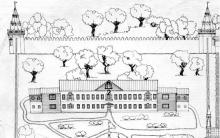
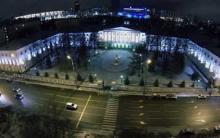
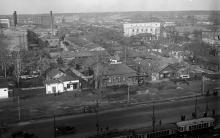
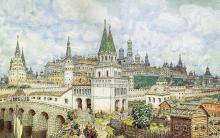
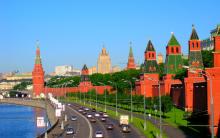
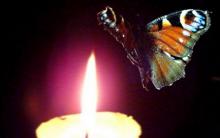




Funeral service and funeral of Archimandrite Kirill Pavlov
The meaning of Aesop's parable of tongues
Pages of Memories (Ariadne Ephron)
How to adjust vacation balances and how to change the number of vacation days per year from a certain date
Document "adjustment of receipts" Adjustment of receipts in 1s 8